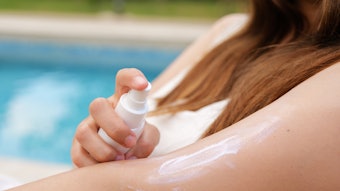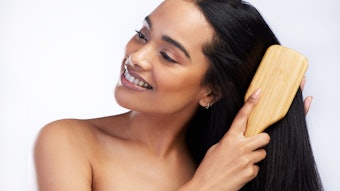Editor’s note: The 2014 graduates of the cosmetics and fragrance marketing and management master's degree program at the Fashion Institute of Technology (FIT) in New York presented their Capstone presentations at “The Changing Face of the Beauty Consumer,” event, sponsored by Unilever U.S., at FIT’s Morris W. and Fannie B. Haft Auditorium on Wednesday, June 4, 2014. This year, students presented on a theme that dives into the challenges shaping the way beauty companies operate from economics to gender to ethnicity.
The following white paper, “Engaging the New Beauty Consumer,” accompanied the presentation from group leader Roshini Greenwald (L'Oréal) and co-leader Jacquelyne Smerklo (Givaudan), as well as Gayathri Balasundar (IFF), Kimberly Lam (Estée Lauder Companies), Deanna Spence (Bath and Body Works) and Brenna Stone (L'Oréal).
Introduction
By 2050, “other” will be the largest projected ethnic group in the United States. People aged 65 and older will outnumber the young. The number of gay couples with children, which has already doubled in the past decade, will continue to grow, as will the evolution of new family units as gender roles continue to blur. As communities expand geographically, travel retail will double by 2020 and grow 5.4% annually over the next 10 years, outpacing the global GDP. What may have been considered the “others” of yesterday will be the majority of tomorrow. This is the reality of the future, and of consumers, and it is not so far away (Pascale, D., & Wendlandt, A. 2013) This changing consumer will have emerging beauty demands that the industry has not yet seen. The current segmentation model used for targeting beauty consumers does not reflect shoppers’ multi-faceted, multi-ethnic, and diverse backgrounds and lifestyles. This in turn limits customer recruitment and retention opportunities for brands.
By implementing a more dynamic approach to consumer insights, brands and retailers will be able to engage with the evolving beauty consumer in a more relevant and authentic way. The winning companies will be those that create the strongest connection to the consumer and deliver the most relevant content.
This paper will explain the short falls of the current consumer segmentation model and provide a new approach for companies and brands to better understand the growing population of “others.” The term “others” is a way to redefine the new beauty consumer. It identifies the marginalized minorities, those who currently might not be clear on which box to check on the census form. “Others” will define tomorrow’s trendsetting majority.
Despite vast diversity amongst consumers of today and consumers of the future, there exist common threads for consumer understanding that brands can utilize to remain relevant and authentic.
The Current Approach
The current consumer segmentation model used for targeting beauty consumers boxes them into the specific demographics of race, age, sex, and geography. These parameters do not reflect psychographics, the attitudes, values, beliefs, and desires of the evolving beauty consumer. The current model is static and linear. It is imperative for brands to engage in a more fluid approach in order to resonate across the consumer’s multi-dimensional value system.
The rising number of “others” in the very near future will have very diverse beauty implications. Demographics alone do not capture a consumer’s cultural values, role in the family unit, and so many other considerations that impact the way they purchase beauty products. Looking at today’s segmentation model, there is no way to deduce these important drivers.
Brands need to evolve from the current boxed segmentation to find out more about the depth and breadth of a person’s true identity. This will provide brands with an opportunity to further explore the layers of a consumer’s individuality. Each of the current segmentation drivers of race, age, sex, and geography are merely starting points for a multifaceted spectrum of interpretations. Clearly, consumers are changing, and yet the beauty industry has not changed the lens through which they view them. By rethinking the current traditional segmentation model, the evolution of the current way consumers self-identify in terms of race, origins, and lifestyle can be understood.
A New Approach
The traditional framework does not capture the multi-faceted nature of consumers. Understanding the deeper associations the consumer has allows engagement in a more relevant and authentic way. “Others” are on the rise.
Race will evolve into a cultural spectrum, where people with diverse backgrounds can share common values. Age will evolve into a cross-generational spectrum of shared passions and interests. Sex will become a spectrum of complex gender identities. Geography will evolve into a series of connections intertwined with notions of community. The existing consumer segmentation model “targets,” while this new dynamic approach “probes” to understand the evolving consumer.
The consumer population of the future will have a majority of “others,” self-identified groups that may look and act nothing like today’s consumers. Brands must take serious consideration of a more holistic consumer view. Detailed in this paper are four spectrums, which describe and illustrate with case studies, brands that are moving in the correct direction, that is, alongside the consumer. This new approach is not about creating four new boxes in which to segment consumers. It is about engaging consumers across the more holistic identity drivers of culture, gender, generation, and community.
Cultural Spectrum
In order to stay relevant, it is no longer adequate to simply speak to a person’s race. Race is a classification system used to identify people according to their physical appearances, geographic ancestry, and inherited characteristics. In order to fully engage with consumers, it is essential to consider their cultural values. A person’s culture includes their beliefs, customs, and norms. One race can have multiple cultural values and one culture can span many races. The reality is that a person’s association with race and culture is dynamic. “Others” do not define themselves by color alone.
By 2019, the white American child will be a minority (Mintel 2011). This reality is fast approaching. Recently, National Geographic published an article with visuals depicting the changing faces of America. As races continue to blend, recessive traits such as red hair, freckles, and blue eyes will become more unusual (Wolchover, 2014). By 2050, 47% of the U.S. will have pigmented skin (Aquino, 2012). Appearance and identity are most certainly linked when it comes to racial categories, but there is another important ingredient that must be considered: experience. There is no room for that on those official census forms, but when a person picks up a writing instrument to choose which box they check, experience most certainly guides their hand (Norris, 2013).
In 2050, 25% of Asian Americans and African Americans will have recent mixed ancestry, as will nearly half of all Hispanic Americans. In fact, the United States is no longer viewed as a melting pot, but as a mosaic, with mixtures of various “ingredients” that keep their individual characteristics (Millet, 2000). This has been seen in the drastic shift from assimilation to multiculturalism to now universalization.
There are 22 different Latino groups in the United States that reflect the ethnic, racial, socioeconomic, and religious diversity of their countries of origin. For example, a black Dominican in New York City would purchase very different products than a white Cuban in Miami and a more recently arrived immigrant will likely purchase products they are familiar with from their home country. Second or third generation Latinos are more influenced by national advertising campaigns (Matusow, 2014). They are looking to build loyalty with brands that properly represent their voice and authentic identity, which empowers their heritage by effectively embedding their cultural characteristics in the ways a brand speaks to them. With $1 trillion in spending power, Latinos are a segment that cannot be ignored.
Therefore, brands are starting to recognize that their “multicultural strategy” must adapt as well. Nothing represents the fusion of cultures more than food. Major consumer packaged goods companies have already started leveraging this spectrum.
Pepsi has introduced the concept of cultural fluency, marketing at an intersection of interests, rather than to one particular group. It is about being inclusive of the entire texture of multicultural consumers. 20% of Pepsi’s market is composed of Latinos. The majority of Latinos are ambi-cultural, with the ability to seamlessly pivot between the English and Spanish languages and to embrace two distinct cultures. Although marketers once felt that Spanish language was the most important piece of the puzzle, they have learned that it is actually about so much more (Wentz, 2003). Race is not the unifier. The multicultural mindset is more about a person’s interests, like music or sports, than whether they are African American or Latino.
Pepsi’s competitor, Coke, has also been focusing on building cultural competencies. They utilize both a Total Universal Integrated Marketing Strategy as well as a Targeted Precision one, designed to celebrate unique cultural experiences. They target consumers all year round instead of focusing solely on stereotypical events such as Cinco de Mayo. This creates an intersection of interests across consumers’ passions and values (Nielsen, 2014). Their “America is Beautiful” Super Bowl campaign was a major source of disruption in the market. The ad featured “America the Beautiful” sung in English, Spanish, Senegalese-French, Hebrew, Mandarin Chinese, Tagalog, Arabic, Hindi, and Keres, a Pueblo language. The song played over a series of scenes depicting the geographic and cultural diversity of the country. In each scene, Coke is portrayed as the common link between people of diverse ethnic and cultural backgrounds (Russo, 2013). It hit a nerve with Americans, either with fear or excitement about the shifting societal changes in this country.
McDonald’s also takes a unique approach to multicultural marketing as they lead with ethnic insights rather than isolating their marketing campaigns by ethnic minority. Their fiesta menu was created utilizing minority taste and flavor preferences to influence the general preference, which became a success in the mainstream market. McDonald’s uses “general marketing” money to back these campaigns (Helm, 2010). Minorities exert an increasingly influential role in McDonald’s traditional advertising as well, as they believe these people provide early exposure to new trends. This is a progressive approach to the traditionally boxed and pinpointed multicultural marketing strategy.
Network television is also noticeably more diverse than ever before. Many shows are implementing color-blind casting where the ethnicity of actors is not considered. Even advertising is more diverse. There’s a clear, simple message that being seen as inclusive is better for brand image. It makes a brand seem more desirable, aspirational, and in tune with a society that is growing more varied and socially tolerant with the generations. The beauty industry has an opportunity to incorporate this color-blind perspective into marketing strategies as well (Davies, 2014).
Cultural relevancy is a two-way conversation. To recruit consumers, find the common thread between race and culture. To retain them, go beyond singular cultural events and engage them 365 days a year.
Generational Spectrum
Similar to boxing people into arbitrary definitions of race, the old targeted marketing model segments people based solely on chronological age. Age is nothing but a number. Analyzing an actual age bracket reveals that a person at the top end of the demographic curve is drastically different than someone at the low end (Bhargava, 2008). To get a more realistic picture of this consumer, they cannot simply be segmented by the year they were born. What matters is relevancy to their core views and individual experience, which may share commonalties across generations. “Others” defy expectations and stereotypes.
A generation’s values have much to do with the parenting style in which they were raised. For the most part, Generation Y has been raised by Baby Boomers, and Generation X is raising Generation Z. Baby Boomers’ parenting style is group-oriented while Generation X’s style is individual-oriented. While both Gen X and Gen Y make up the current 18-49 demographic, they tend to have vastly different values and beliefs, showing that there are more relevant indicators than age as a number.
Generation Y and Generation Z are both viewed as the future, and the groups that companies need to learn how to market to in this ever changing digital age. Generation Z is the first generation to have been connected to the Internet for their entire lives. All, 100%, are connected for one or more hours per day, and about half, 46%, are connected more than ten hours per day (Needle, 2013). They are also the first to be truly skeptical of the “American Dream.” Both Gen Y and Z, however, believe that they have the power to change things and know how to impact change through social media.
For the first time in history, consumers aged 20 and aged 60 are listening to the same music and going to the same concerts. This presents brands with new opportunities to connect with audiences across multiple generations. Music has a universal appeal, which allows brands to connect with people in a more engaging and emotional way. Music can tie together the goals, achievements, and landmark moments relevant to a particular life stage. Using nostalgia is not groundbreaking, but if done right it can be the bond between generations. This convergence in taste can also strengthen the retail experience. Research shows that music encourages people to shop longer in stores. Research also shows that 90% of people would recommend a store that plays music (Tesseras, 2014). Successful brands such as MAC utilize music to create unique in-store experiences. Music transcends all generations.
By segmenting generations, many brands are missing out on an opportunity to capitalize on women who feel that they are “18 with 32 years of experience.” Typically, beauty brands steer these consumers away from color cosmetics and towards expensive skin care, often making them feel uncomfortable in a setting that is “too young” for them. In reality, there is still a need and want for color cosmetics purchases at all ages. Some beauty brands have started to break the unspoken prejudice of age. Illamasqua launched “Beauty Before Age” with products that are transcendent of age and allow anyone to feel empowered and beautiful. The brand is never defined by social demographics, age, or sex, but simply by a mindset. People of any age are encouraged to celebrate their experience and vitality rather than hiding behind the number. Marc Jacobs Beauty famously chose 64-year-old Jessica Lange as the face of the brand and Nars employs 68-year-old Charlotte Rampling as a spokesperson.
Brazilian beauty company Natura created Vovo fragrance products designed to promote physical and emotional contact between grandparents and grandchildren. They used scent as the common thread to create a connection across generations (Stylus, 2014).
Brands can also appeal to multiple generations through different value sets. Prius is an environmentally friendly, fuel-efficient vehicle that resonates with Millennials and Boomers. 64% of Millennials rank “making the world a better place” as their priority in life and this hybrid car allows them to feel as if they are truly making a difference (Lily, Unilever). The value proposition for Baby Boomers is saving money, as 57% say their household finances have worsened since the Great Recession. A higher share of Boomers say they have cut spending in the past year and around six out of 10 have to postpone retirement (Pew Social Trends). Prius saw the opportunity to be universally appealing to multiple generations for various reasons and is a strong example of how to reach more consumers rather than isolating some based on age brackets.
Age does not define product need, even in beauty. Generational values are a much stronger indicator of a consumer’s purchase intent.
Gender Spectrum
The standard definition of a man or a woman does not drive lifestyle or consumer needs anymore. Society’s established norms no longer apply to everyone. Gender roles are blurring and brands can capitalize on the ability to further drive change. There are three specific areas relating to gender roles that are already experiencing dramatic change: family unit, gender blurring, and sexual orientation. “Others” are not always one thing or another.
Women are not limited in the same way they once were; they graduate from college at higher rates than men. While most couples are evenly matched scholastically, 28% of married women are better educated than their mates, which is true of just 19% of married men (Angier, 2013). The number of stay-at-home fathers in the United States has more than doubled in the past 10 years. Nearly half of men would like to see more ads tailored specifically to their needs and interests. Additionally, more than half of men agree that fathers today take a more active role in parenting than they have in the past (Cassandra, 2013).
It wasn’t long ago when parents dressed their children in white dresses and diapers. From a practicality standpoint, white cotton could be bleached. In fact, gender-neutral clothing was the norm. In 1927, Time magazine printed a chart showing sex-appropriate colors for girls and boys according to leading U.S. stores. In Boston, Filene’s told parents to dress boys in pink. So did Best & Co. in New York City, Halle’s in Cleveland, and Marshall Field in Chicago. The reason was that pink, being a more decided and stronger color, was more suitable for the boy, while blue, which was more delicate and dainty, was prettier for the girl. Today’s color dictate wasn’t established until the 1940s, as a result of Americans’ preferences, as interpreted by manufacturers and retailers. Now, one can easily tell if a baby is a boy or girl based on blue or pink cues. (Maglaty, 2011). Western culture views gender as a linear concept with two options: male or female. Expression and identity can be seen as a spectrum of multi-dimensional possibilities.
Gender neutral clothing is having a resurgence. For example, Manila-based brand Proudrace, creates gender neutral clothing influenced by the 1990s, sports hybrids, and youth culture. Proudrace found a common ground to produce clothing that is androgynous without being contrived (Santiago, 2010). Fashion brands like Proudrace are blurring traditional notions of gender and embracing the common interests of all people.
Just as there is fluidity in sexual identification, gender does not solely define consumer values. Many people do not see the need for such strict parameters. Facebook, for example, gives 56 options for gender, allowing a person to use 10 at a given time on their profile. Users have been requesting the ability to reflect their gender accurately, so Facebook worked with leading LGBT figures in order to come up with the new terminology. This customized option allows users to feel comfortable and authentic to themselves while connecting with people, causes, and organizations that they care about (Griggs, 2014).
3.5% of Americans identify as LGBT and 19 million report that they have engaged in same-sex behavior (Gates, 2011). The Spring 2014 Barney’s “Brothers, Sisters, Sons, and Daughters” campaign brought attention to the transgender community by featuring 17 of these models in their ads. One model was quoted as saying, “if gender is black and white… then I am gray.”
New family structures, called “start up” families are replacing the traditional family unit from decades past. A growing number of gay men and lesbians are pursuing parenthood, which is creating a “gayby” boom. In fact, gay couples with children have doubled in the past decade and there are currently over 100,000 same sex couples raising children (Angier, 2013). In fact, only 19% of families are traditional, as defined by mom, dad, and 2.4 kids (Stylus, 2014).
Recently Honeymaid aired a new brand advertisement featuring a two-dad family, a rocker family, a single dad, an interracial family, and a military family with the tagline, “no matter how things change, what makes us wholesome never will” (Solomon, 2014). This ad shows diversity but goes a step further and labels these families as “wholesome,” which implies that family values are deeper than typical stereotypes. Diverse parents with dynamic roles are the future and other industries have already evolved their communication to reflect this new norm.
There is an aspirational way to still be inclusive, and the beauty industry can take cues from these companies to evolve marketing strategies to more accurately reflect today’s changing society.
Community Spectrum
Consumers are constantly balancing their sense of self with their awareness of community. People’s communities are becoming larger, both virtually and physically, through social media and travel. In turn, they are struggling to define their self-identity amidst these wide communities. “Others” don’t stay in one place.
Generation Y moms report feeling twice as lonely as Generation X moms, despite having double the social network. The reason they point to is that motherhood is so diversified today that it is just harder to find other moms “like me,” which points to a new form of loneliness emerging from a lack of relatability. The Curve Report findings describe a generation that will have far less in common with their peers than members of the previous generation did and consequently, will have a harder time finding others “like them.” All this adds up to a wide set of highly disparate interests, which will present a new challenge for brands. (PSFK, 2013).
Social networking has completely reshaped the way humans interact. According to a Ted Talk by Sherry Turkle in February 2012, more and more people are defining themselves as lonely. People are collecting friends like stamps, not distinguishing quality versus quantity. Friendship is now understood as chat conversations and photo exchanges. Instead of building true friendships, people are obsessed with self-promotion. In reality, however, people are vulnerable and lonely. Social networking allows them to present themselves as they wish to be seen, with the ability to edit and delete. People are faking experiences so they will have something to share (Turkle, 2012). Brands have the opportunity to address this by connecting with consumers in the deeper way they are missing.
There is, in fact, a way to integrate today’s technology with a more authentic sense of community. Restaurant chain, HAI - DI – LAO in China, has pioneered the first tele-dining experience, allowing families living apart to connect virtually over dinner (Stylus, 2014).
Beyond virtual, communities are physically growing as travel is on the rise. With a growing and increasingly global network, consumers have developed a dynamic and evolving relationship with both their own values and their commitment to their communities. While new consumers want to develop a wide, global, diverse network, they are also interested in self-expression coupled with a need for a sense of belonging. This balance highlights the future consumer’s empowerment as well as need for self-identity.
In China, a BBDO study conducted amongst affluent Chinese youth uncovered that they question the super competitive, fast speed of urbanization in favor of a stronger sense of morality in the community. They are starting to take a deeper look inward to their community and rebuild the basic values that bring people together, namely morality, humbleness, and fairness. They are evolving toward a balance between individual ambition and the pace of their society today.
Consumers today feel a constant push and pull between belonging to their community and their own self identity. They balance a want for external validation with a need for choice and empowerment. One brand that has addressed this new sense of community is Sprint. Their new Framily Plan allows consumers to build cell phone plans inclusive of family and friends, redefining a person’s closest sense of community (Sprint, 2014). Sprint is playing on the juxtaposition of a broader sense of community with a sense of self as all of their ads highlight “separate bills available!”
Beauty brands must customize experiences for consumers that allow them to simultaneously engage with their community and build their sense of self. Beauty as an industry already balances consumers’ internal and external motives, which provides a clear opportunity to further incorporate this balance into our engagement strategies.
Future Approach
One quintessential example of a brand successfully tapping into each of the four spectrums, culture, generation, gender, and community, is Coca Cola. They recently partnered with Google to reimagine their 1971 campaign “I’d like to buy the world a Coke.” They developed a digital platform using online ads and specially developed vending machines to enable users to buy a can of Coke for someone across the world, along with a personalized video message. This demonstrates the power of breaking barriers and connecting people of all cultures, generations, genders and communities (Wasserman, 2012). This is the power of Coke’s brand DNA that resonates across all spectrums of people.
In the near future, there will be technology that will allow brands to penetrate to a deeper level of granularity. Neurosensory technology will measure and track emotional states as well as physical vitals to better understand what drives consumer actions. This can be used to help craft custom products and services that are ultra tailored to consumer needs.
Recommendations
“Others” are already evolving from today’s consumers and brands cannot wait for technology to weave the threads together. They must start engaging the “others” today. There are four key concepts the beauty industry can rethink to take steps, or leaps, in the right direction.
Rethink The Common Thread.
How can brands engage consumers beyond demographics? True engagement is through a cultural exchange between brand values and consumer values. Rather than approaching the “others” with a visual of multicultural models, go deeper to understand whether a visual that cues individuality or close-knit community will resonate more with consumers. Beauty brands need to develop a cultural fluency that goes beyond projecting racial elements through existing brand formats. For “others”: engage = exchange.
Rethink the Consumer’s Reality.
How can beauty brands break through the clutter? Breaking through the clutter is, in fact, brand focused, not consumer focused. This approach disrupts the consumer’s reality in favor of pushing the brand message to the forefront. Instead, understanding and engaging with the consumer’s reality provides for a more meaningful and lasting connection. For example, instead of promoting products only around key holidays, find the moments that transcend culture and generation to celebrate with consumers throughout the year. It could be as simple as celebrating firsts, a first date, first job, or first day of school, which hold a lot of emotional significance for so many people. These are the moments that deeply matter to all consumers and offer an opportunity for brands to stay relevant everyday with everyone.
Rethink Connectivity.
How can beauty brands stay relevant as technology evolves? Don’t confuse technology with real connection. Optimize education to be consumer focused, not product focused. With each transaction, the goal should be to learn three interests or facts about the consumer, unrelated to the product sale. Developing real and personalized experiences will engage these consumers over and over. Beauty brands have the potential to become real members of their consumers’ communities.
Rethink the Corporate Framework.
How can beauty brands implement a more dynamic culture within their organizations? Many companies have isolated departments developing multicultural strategies. There is an opportunity to take cues from consumer packaged goods companies like Pepsi to ensure that every member of the team has expertise in consumer insights. In beauty, rather than having multicultural experts, have teams focus on finding the intersection of interests across cultures, generations, genders, or communities.
Conclusion
Demographic data such as race, age, sex, and geography can only reveal one dimension of a person’s overall fluid identity. In order to truly engage with the multi-faceted and dynamic consumer, companies need to reach them on a deeper level.
By removing the terms race, age, sex, and geography from brand vocabulary in place of a spectrum of culture, generation, gender, and community, the beauty industry can become the leader in understanding and engaging the new consumer. People who look like “others” today will in fact define the beauty ideals of tomorrow.
Brands have the opportunity to leverage existing products by evolving the strategy to focus on cultural values, shared interests, or common aspirations to engage the new beauty consumer in a meaningful and lasting way.
The beauty industry, looking to engage the evolving beauty consumer, must acknowledge that “others” are the ones who will drive society forward and in the end, “others” will make or break the bottom line.
The reality is fast approaching when a new shade will, in fact, be born every day, and the beauty industry is at a critical tipping point to embrace this evolving new consumer.
References
- Angier, N. (2013, November 25). The Changing American Family. The New York Times.
- Ard, H. (2013, September 23). The Third Revolution. Retrieved April 5, 2014, from http://www.stylus.com/tnvfth.
- Aquino, R. (2012, September 19). Q&A with BBR8 Thought Leader – Aliesh Pierce – “Advances in Multi-Ethnic Cosmetics.” Retrieved May 9, 2014, from http://mazurgroupla.com/qa-with-bbr8-thought-leaderaliesh-pierce-advances-in-multi-ethnic-cosmetics/.
- Baron, K. (2013, September 27). Female Focused Retail. Retrieved April 5, 2014, from http://www.stylus.com/tsrvqj.
- Bhargava, R. (2008, October 20). Why Only Stupid Marketers Use Age As A Demographic. Retrieved May 9, 2014, from http://www.rohitbhargava.com/2008/10/why-only-stupid.html.
- Broughton, A. (2008, August 13). Minorities expected to be majority in 2050. Retrieved May 9, 2014, from http://www.cnn.com/2008/US/08/13/census.minorities/.
- Bruni, F. (2014, April 5). The New Gay Orthodoxy. The New York Times. Retrieved from http://www.nytimes.com/2014/04/06/opinion/sunday/bruni-the-new-gay-orthodoxy.html.
- Callahan, N. S. (2013, August 19). “Mixed Kids Are Always So Beautiful.” Motherlode Retrieved April 5, 2014, from http://parenting.blogs.nytimes.com/2013/08/19/mixedkids-are-always-so-beautiful/?_php=true&_type=blogs&_r=0.
- The Cassandra Gender Report Summer/Fall 2013.
- Cross, A. (2014, March 28). Mixed-Race: Not Half-and-Half. The Phillipian. Retrieved April 5, 2014, from http://www.phillipian.net/articles/2014/03/27/mixed-race-not-half-and-half.
- Davies, M. (2014, May 16). Network Television Is More Diverse Than It’s Been in Decades. Retrieved May 21, 2014, from http://jezebel.com/network-television-is-morediverse-than-its-been-in-dec-1577114222?utm_campaign=socialflow_jezebel_facebook&utm_source=jezebel_facebook&utm_medium=socialflow.
- Finkel, E. “The All-or-Nothing Marriage.“ The New York Times. 15 Feb. 2014. Web. 6 Mar. 2014. http://www.nytimes.com/2014/02/15/opinion/sunday/the-all-or-nothing-marriage.html.
- Franco, J. “The Meanings of the Selfie.” The New York Times. 28 Dec. 2013. Web. 6 Mar. 2014. http://www.nytimes.com/2013/12/29/arts/the-meanings-of-theselfie.html.
- Fundenburg, L. The Changing Face of America. National Geographic. Retrieved January 2, 2014, from http://ngm.nationalgeographic.com/2013/10/changing-faces/funderburg-text.
- Gates, G. “How Many People Are Lesbian, Gay, Bisexual, and Transgender?” The Williams Institute, Apr. 2011. Web. 20 Apr. 2014. http://williamsinstitute.law.ucla.edu/.
- Gobe, M. (2009). Emotional branding the new paradigm for connecting brands to people. New York: Allworth Press.
- Griggs, B. (2014, February 13). Facebook goes beyond ‘male’ and ‘female’ with new gender options. Retrieved May 9, 2014, from http://www.cnn.com/2014/02/13/tech/socialmedia/facebook-gender-custom/.
- Harris, E. (2014, January 16). Target tests small store for urban shoppers as young people pick cities over suburbs. The New York Times, p. 4.
- Helm, B. (2010, July 8). Ethnic Marketing: McDonald’s Is Lovin’ It. Bloomberg Businessweek.
- Hernandez, J. “The Future of Multicultural Marketing in America.” Brand Lateen RSS. N.p., 02 Oct. 2011. Web. 01 Mar. 2014.
- Iman. “Think Tank: Iman on the Multicultural Consumer.” WWD. N.p., 8 Feb. 2013. Web. 24 Feb. 2014.
- Kotkin, J., & Schill, M. (2013, September 23). A Map of America’s Future: Where Growth Will Be Over The Next Decade. Forbes, 2013, 18.
- Looper, L. (2011 5–23). HowStuffWorks “How Generation Z Works.” HowStuffWorks. Retrieved March 6, 2014, from http://people.howstuffworks.com/culture-traditions/generation-gaps/generation-z.htm.
- Maglaty, J. (2011, April 8). When Did Girls Start Wearing Pink? The Smithsonian.
- Matusow, J. (2014, January 2). Lining up for the Latino market. Beauty Packaging.
- Membis, L. (2010, September 13) Is Ethnic Beauty the New “it” factor? CNN. Retrieved April 7,2014 from http://www.cnn.com/2010/LIVING/09/13/ethnic.beauty/.
- Millet, J. (2000, January 1). Understanding American Culture From Melting Pot to Salad Bowl. Retrieved May 9, 2014, from http://www.culturalsavvy.com/understanding_american_culture_2.htm.
- Mintel “The Great White Minority” 7, April 2011.
- Nielsen “Demystifying Multicultural Consumers” 29, April 2014.
- Nittle, N. K. (2010, February 1). What Is Internalized Racism?. About.com Race Relations. Retrieved April 5, 2014, from http://racerelations.about.com/od/understandingrac1/a/internalizedracism.htm.
- Needle, D. (2013, March 19). Teens stay online more than they did just 3 months ago; tablets a big reason why. Retrieved May 10, 2014, from http://tabtimes.com/news/marketing/2013/03/19/teens-stay-online-more-theydid-just-3-months-ago-tablets-big-reason-why.
- Noris, M. (2013, September 17). Visualizing Race, Identity, and Change. National Geographic.
- Pascale, D., & Wendlandt, A. (2013, December 18). Luxury brands step up battle for travelling shoppers. Reuters.
- Perez, A. D., & Hirschman, C. (2010, June 9). The Changing Racial and Ethnic Composition of the US Population: Emerging American Identities. Retrieved March 20, 2014, from http://www.ncbi.nlm.nih.gov/pmc/articles/PMC2882688/.
- Perez, G. “Marketing to the Multicultural Consumer.” Advertising Research Foundation’s (ARF) 2011 Annual Re:think Convention. 26 Jan. 2012. Speech.
- PSFK, with The Curve Report from NBCUniversal Content Innovation and Creative Marketing, is examining the future of Gen Z. 13, December 2013.
- Racoma, B. (2013, March 4). Top 10 Culturally Diverse Cities in the World. Day News RSS. Retrieved April 5, 2014, from http://www.daynews.com/latestnews/2013/03/top-10-culturally-diverse-citiesin-the-world-15031.
- Rousmaniere, D. (2013, May 24). A Futurist Looks at the Future of Marketing. Harvard Business Review.
- Russo, M. (2014, February 26). Diversity is beautiful: Americans should celebrate cultural and linguistic differences rather than trying to neutralize them. Retrieved May 9, 2014, from http://www.cavalierdaily.com/article/2014/02/russo-diversity-is-beautiful.
- Santiago, N. (2010, May 10). BOUTIQUE OF THE WEEK: PROUDRACE Get to know the online label and shop its dark, brooding, futuristic styles. Retrieved May 9, 2014, from http://www.stylebible.ph/fashion/style-report/boutique-of-the-week-proudrace/?ref=prev_top#undefined.
- Sell, S. (2013, October 11). Empowering Global Women. Retrieved April 5, 2014, from http://www.stylus.com/qhnzsk.
- Shapiro, B. “Makeup That Addresses the Many Shades of Women” The New York Times. 19 March. 2014. Web. 20 Mar. 2014. http://www.nytimes.com/2014/03/20/fashion/makeup-foundation-for-the-many-shades-of-women.html?_r=0.
- Solomon, A. (2014, April 5). Honey Maid And the Business of Love. The New Yorker.
- www.sprint.com.
- Stylus Forum “Modern Family” 2014.
- Ted Talk “Connected by alone?” 2012 Sherry Turkle.
- Tesseras, L. (2014, April 9). Brands can engage multiple generations with pop music. Marketing Week.
- Walter, E. (2013, December 17). 2014 Digital Trends And Predictions From Marketing Thought Leaders. Forbes.
- Ward, C. (2013, September 23). New Rules for Marketing to Women. Retrieved April 5, 2014, from http://www.stylus.com/ctdjyw.
- Wasserman, T. (2012, August 7). How Coke Spread Happiness (and Cokes) via Mobile. Retrieved May 21, 2014, from http://mashable.com/2012/08/07/coke-happiness-mobile/.
- Wentz, L. (2003, July 7). Pepsi puts interests before ethnicity. AdAge.
- Wolchover, N. “What Will Future Humans Look Like?” Live Science, September 2012. Web. 20 Apr. 2014. http://www.livescience.com/34228-will-humans-eventually-all-looklike-brazilians.html.
Industry Expert Interviews:
Castro, M. Phone Interview, MAC Global consumer insights. 10, April 2014.
Gottlieb, Ann. Interview, Ann Gottlieb Associates. 28 April 2014.
Lilly, Russell, Unilever
Navia, Alyssa. Phone Interview, L'Oréal Luxe Global Shopper. 4, April 2014.
Robinson, Aja. Phone Interview, L'Oréal Luxe Multi Cultural Consumer. 2, April 2014.











